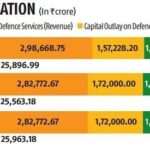
Defence minister says earlier governments considered border as last areas of country. Modi govt considers border areas as the “face of India”
By Vikas Gupta
Defence News of India, 22nd Jan 24
In 2017, the 19th National Congress of the Chinese Communist Party (CCP) announced with fanfare a new border village policy: This involved resettling Tibetan graziers in “model villages” in disputed areas along the Sino-Indian border.
In fact, the Chinese border policy had already been implemented since 1995. In an acclaimed investigative article in May 2021, in Foreign Policy magazine, Tibetologist Robert Barnett recounted how this worked: Since 1995, CCP officials in Tibet had ordered border graziers not to return to their villages in winter. Instead, they were to spend winter driving their yak herds over disputed land and planting Chinese flags on peaks.
In a few years, Chinese claims over large areas had solidified, with some 250,000 Tibetan graziers resettled thus in vulnerable pockets along the border.
In July 2021, China’s President Xi Jinping visited Tibet for three days, to hail the graziers as defenders of the border and heroes of China.
On Friday, the Indian government, which has been slow to enter this game, finally took a seat at the table.
In Uttarakhand, while dedicating 35 bridges and six new roads to the nation, Defence Minister Rajnath Singh said the Bharatiya Janata Party (BJP) government considers border areas a part of the national mainstream and not just a buffer zone as the earlier Congress-led governments did.
Rajnath Singh said that Prime Minister (PM) Narendra Modi’s approach towards border area development was unique. “Other governments did not focus on development of border areas as they considered these zones as the last areas of the country. We, on the other hand, consider border areas as the face of India, which is why we’re ensuring that world-class infrastructure is created in these zones,” he said.
The defence minister stressed that connectivity is being provided to every border area in the country through roads, bridges and tunnels. He described the work as not only of strategic importance, but also pivotal for the welfare of the people residing in these regions.
“People living near the borders are no less than soldiers. If a soldier protects the country by wearing a uniform, the residents of border areas are serving the motherland in their own way,” he said.
“There was a time when border infrastructure development was not given much importance. Governments used to work with the mentality that the people living in the plains are the mainstream people. They were worried that the [infrastructure] development on the border might be used by the adversary. Due to this narrow mentality, development never reached the border areas,” said Rajnath.
“This thinking has changed today. Under the leadership of PM Modi, our government is committed to the development of border areas, keeping in view the nation’s security needs. We do not consider these areas as buffer zones. They are a part of our mainstream,” he said.
The defence minister said that the government’s approach shows a new confidence of “New India”, which will not wait for potential adversaries to reach the plains to deal with them. “We are developing infrastructure on the mountains and deploying the troops on hill borders in such a way that it is ensuring the safety of the people there, and helping the military to effectively deal with our adversaries,” he said.
Referring to the large migration from border areas in Uttarakhand, Rajnath Singh termed it a matter of concern. He said the PM and the chief minister were taking infrastructure development to the last Indian on our side of the border.
In his address, the defence minister “commended the BRO for strengthening the border infrastructure of the country and asserted that by constructing roads, bridges etc., the organisation is connecting the far-flung areas with the rest of the nation geographically, while also linking the hearts of the people residing in remote villages with the rest of the citizens,” said a defence ministry press release.
The defence minister described the personnel engaged with the BRO – including army personnel, permanent civilian employees and casual paid labourers (CPLs) – as a unique workforce. Highlighting the change in the mindset brought out by the government, he said with respect to the CPLs: “Earlier, only permanent employees were considered part of the organisation; not those hired through outsourcing or those working on a contract/casual basis. Today, this mentality has changed. We believe that it is only through the combined efforts of all can the nation move forward on the path of development.”






